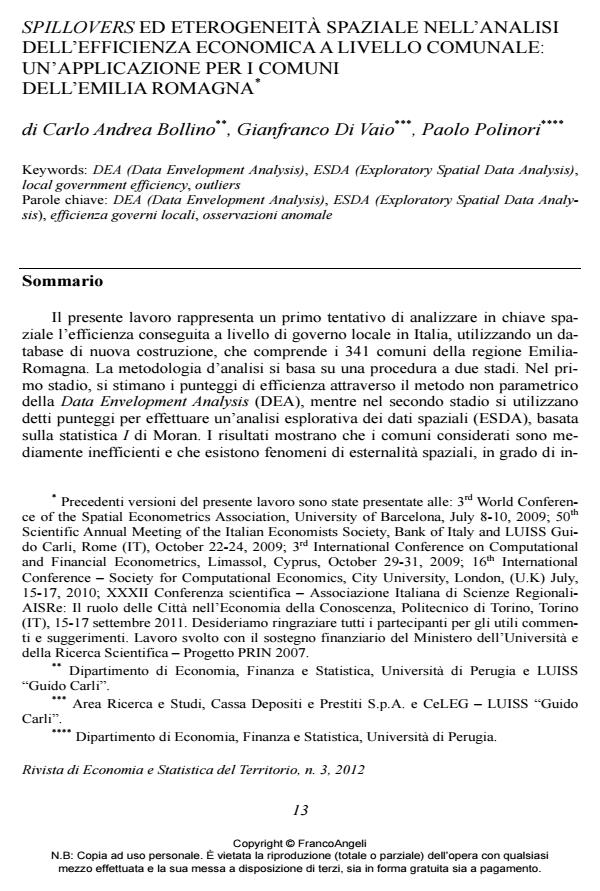Spatial spillovers and spatial heterogeneity in local government efficiency: an application to a sample of Italian municipalities
Journal title RIVISTA DI ECONOMIA E STATISTICA DEL TERRITORIO
Author/s Carlo Andrea Bollino, Gianfranco Di Vaio, Paolo Polinori
Publishing Year 2012 Issue 2012/3
Language Italian Pages 25 P. 13-37 File size 905 KB
DOI 10.3280/REST2012-003002
DOI is like a bar code for intellectual property: to have more infomation
click here
Below, you can see the article first page
If you want to buy this article in PDF format, you can do it, following the instructions to buy download credits

FrancoAngeli is member of Publishers International Linking Association, Inc (PILA), a not-for-profit association which run the CrossRef service enabling links to and from online scholarly content.
The aim of this work is to identify the existence of spatial spillover and spatial heterogeneity in local government efficiency, by using data from a newly constructed database about 341 municipalities from the Italian region Emilia- Romagna. Methods and Results The methodology is based on a two-step procedure. In the first step, cost efficiency scores are estimated by means of non-parametric Data Envelopment Analysis (DEA). In the second step, an Exploratory Spatial Data Analysis (ESDA), which is based on Moran’s I statistic, is applied to the efficiency scores computed in the previous step. Results show that municipalities are cost inefficient, on average, and that positive spatial externalities, in the form of positive spatial autocorrelation, influence the efficiency performance of local government. In particular, municipalities with a high degree of cost efficiency are surrounded by municipalities with a similar level of efficiency and vice versa. At the same time, results also show the existence of relevant spatial heterogeneity. Particular attention has been paid to the heterogeneity coming from outlying observations. Conclusions In this work we show the existence of spatial externalities in local government efficiency across municipalities from the Italian region Emilia-Romagna. Spatial spillovers provide evidence favoring theories of yardstick competition or phenomena like monitoring, benchmarking and knowledge transfer across space. At the same time, the presence of relevant spatial heterogeneity should be further investigated.
Keywords: DEA (Data Envelopment Analysis), ESDA (Exploratory Spatial Data Analysis), efficienza governi locali, osservazioni anomale
Jel codes: C21, C61, R38.
- Spatial effects on local government efficiency Raffaella Santolini, in Papers in Regional Science /2020 pp.183
DOI: 10.1111/pirs.12475 - Spatio-temporal modelling of municipal waste management systems’ meta-efficiency scores Marialisa Mazzocchitti, Chrisovalantis Malesios, Alessandro Sarra, in Applied Economics /2022 pp.3709
DOI: 10.1080/00036846.2021.1939855 - The role of spatial interdependence in local government cost efficiency: An application to waste Italian sector Elisa Fusco, Veronica Allegrini, in Socio-Economic Planning Sciences 100681/2020 pp.100681
DOI: 10.1016/j.seps.2019.01.003
Carlo Andrea Bollino, Gianfranco Di Vaio, Paolo Polinori, Spillovers ed eterogeneità spaziale nell’analisi dell’efficienza economica a livello comunale: un’applicazione per i comuni dell’Emilia Romagna in "RIVISTA DI ECONOMIA E STATISTICA DEL TERRITORIO" 3/2012, pp 13-37, DOI: 10.3280/REST2012-003002